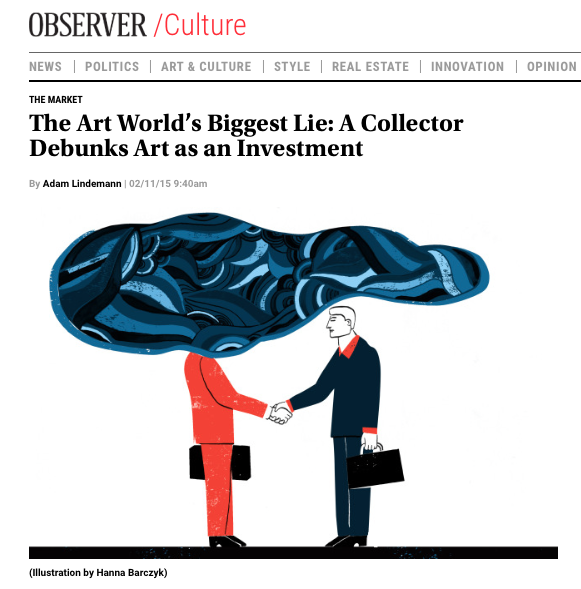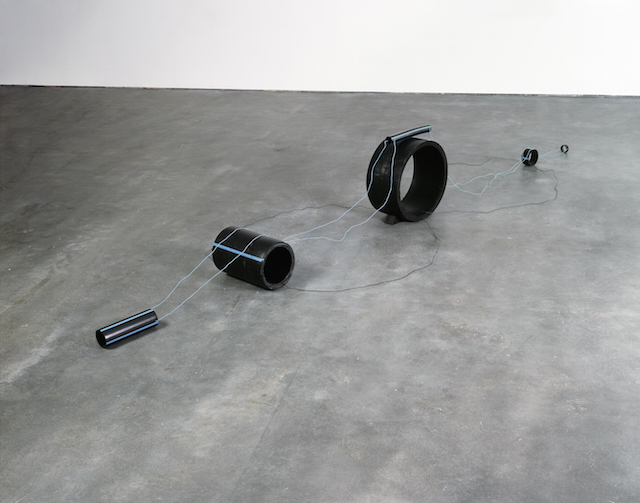It’s a Sunday morning so cold outside that it hurts. On the bright side, Valentines Day is over! You might as well keep your bathrobe on and drink another cup of coffee. It’s time to catch up on the week’s headlines, courtesy of BmoreArt.
“The last several years have brought nosebleed prices for works of art, auction records that seem to be broken almost as soon as they are made. With endless media coverage of $100 million Picassos and $50 million Jeff Koons sculptures, the general public is often left with the impression that art has not only been a great investment, it’s been the investment of late.
I, too, have taken part in the hype, by selling works into this feeding frenzy, and by writing a popular book of insights by top collectors and dealers. Collecting Contemporary was published back in 2006, and 100,000 copies in four languages were sold by the savvy German publisher Benedikt Taschen. As it turned out, there was a whole world of new buyers eager to find a “how to” manual to guide them through the labyrinth of “art as gold,” and the book found its way into classrooms and Internet cafes.”
You can read Lindemann’s whole confession at The Observer.
<<><><><><><><><>
NextCity.org: Cities Make Affordable Housing Plays to Hold on to Artists by Alexis Stephens, published February 6, 2015
“While the arrival of sculptors, mixed-media painters and the like may foreshadow rising rents, there are many artists who struggle to afford city life. Across the country this week, several cities took steps to ease that struggle.”
This article has an upbeat message, but it unwittingly points out how clueless city officials are about the value and needs of artists. New York Mayor Bill de Blasio touted a plan to create 1,500 new units of affordable housing for artists by 2024 in order to retain the “cultural capital” of the country. Are you reading those numbers a second time? 1500 affordable units in the next ten years? To retain artists in the most expensive city in the country? Let’s not hold our breaths. The other two efforts? Nashville receives $200k to help artists buy and rehab live-work spaces and Minneapolis opens ‘Artist Lofts’ in the historic Pillsbury mill that will cost $974 a month. I am sorry but I am underwhelmed. Link here.
<><><><><><><><>
If you wanted to know more about gentrification in New York City, public programs purported to help artists, and the funding involved, read Andrew Padilla’s Feb 5 account of applying for Artspace PS109. This is what scares me most about what may come to Baltimore.
A Rejected Artist in NYC: Who Really Wins Affordable Housing Lotteries?
I am one of hundreds of East Harlem artists denied housing at Artspace PS109.
In the summer of 2014, 53,000+ people applied to live in 89 affordable apartments at Artspace PS109. This has become an all too common scene in New York City’s housing market. Decades of public subsidies and assistance for luxury development in NYC have increased property values and rents all across the city. This rise has led to the displacement of working- and middle-class families. The main “community benefit” in return for publicly assisted displacement has been the opportunity to enter an affordable housing lottery and hope Yolanda Vega calls your number, allowing you to remain. Mayor Bill de Blasio has continued along the same path, pushing for taller and denser private developments in working-class communities of color and offering 80,000 “affordable” lottery tickets in exchange.
In his State of the City address, the mayor also promised to include 1,500 new affordable live-work spaces for New York City artists by 2024 as part of his 80,000 “affordable” unit pledge. East Harlem, one of the neighborhoods the mayor has targeted for rezoning, has just completed an affordable housing complex for artists: PS109. Read it here.
<><><><><><><><>
Hyperallergic: Al Taylor: Not Yet in from the Cold by John Yau
“New York’s art world institutions still haven’t recognized how good an artist Al Taylor was. They overlooked his work while he was alive, and seem hellbent on continuing that willful blindness now that he is dead. Although Taylor moved to New York from Kansas City in 1970 and largely worked here until his death in 1999, most of the attention his work has received has been miles from Manhattan.” Read it here.
<><><><><><><><><>
Washington Post: Adjunct professors get poverty-level wages. Should their pay quintuple?
Inside the fight to dramatically hike pay for adjunct professors, who are now a majority in higher education By Lydia DePillis February 6, 2015
“It’s been true for a long time now that academia — or at least the part of it that teaches students — relies heavily on the labor of adjunct faculty. As the number of tenured professors has fallen, universities have filled more than half of their schedules with teachers who work on contract. And no wonder: They’ll work for less than half what a full-time professor makes, at a median wage of just $2,700 per course, with scant benefits, if any.
“Now, a union that’s been rapidly organizing adjuncts around the country thinks that number should quintuple. Last night, on a conference call with organizers across the country, the SEIU decided to extend the franchise with a similar aspirational benchmark: A “new minimum compensation standard” of $15,000. Per course. Including benefits.”
I don’t have much to add to this, but this is a thorough article. It points on the pro’s and con’s of paying adjunct professors equitably. Read it here.
<><><><><><<><><>
“In order to solve problems at the magnitude they exist, it is critical to understand the root causes of those problems. In the case of the growing and related issues of racial inequality and poverty, we must openly acknowledge that the problem exists, and then explore the factors at the root of that problem. Sadly, statistics from high school dropout to incarceration rates point to the reality that in America, racial discrimination is one of the most significant root causes of inequality in education, health, and wealth outcomes.”
More on solutions to the problem here.
<><><><><><><>
If Artists were the Mayors of Baltimore… Well, that’s kind of a scary thought. But, it made for an opinionated and lively conversation on the Marc Steiner Show. If you missed us this past week, take a listen to myself, Michelle Gomez, Paul Rucker, and David Mitchell discussing social, economic, racial, and creative issues within the arts:













